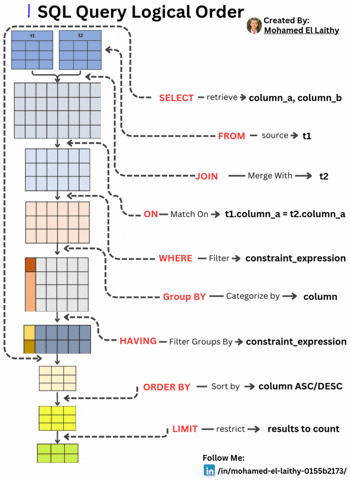SQL Query Logical Order
SQL Query Logical Order: A Step-by-Step Breakdown Understanding the logical execution order of an SQL query is essential for writing optimized and efficient database queries. Unlike the typical SQL syntax order, the execution follows a systematic approach. Here's a breakdown: FROM – Identifying the Data Source The query execution starts by selecting the main table (t1) from which data will be retrieved. This step lays the foundation for subsequent operations. JOIN – Merging Tables If multiple tables are involved, the JOIN operation merges another table (t2) based on specified conditions, preparing a unified dataset for filtering and processing. ON – Defining Match Conditions The ON clause establishes the conditions for the JOIN, ensuring the correct records are linked, typically using a primary-foreign key relationship (e.g., t1.column_a = t2.column_a). WHERE – Filtering Rows The WHERE clause applies constraints to filter rows before any aggregation or grouping occurs, enhancing query performance by reducing unnecessary computations. GROUP BY – Categorizing Data Data is then grouped based on a specific column, enabling aggregate functions like COUNT(), SUM(), and AVG() to operate on each group efficiently. HAVING – Filtering Groups Unlike WHERE, which filters individual rows, HAVING filters grouped results based on conditions like HAVING COUNT(*) > 10. ORDER BY – Sorting the Results The query results are then sorted in ascending (ASC) or descending (DESC) order based on one or more columns, ensuring structured output. LIMIT – Restricting the Output Finally, the LIMIT clause restricts the number of rows returned, optimizing performance and preventing unnecessary data retrieval.

SQL Query Logical Order: A Step-by-Step Breakdown
Understanding the logical execution order of an SQL query is essential for writing optimized and efficient database queries. Unlike the typical SQL syntax order, the execution follows a systematic approach. Here's a breakdown:
FROM – Identifying the Data Source
The query execution starts by selecting the main table (t1) from which data will be retrieved. This step lays the foundation for subsequent operations.JOIN – Merging Tables
If multiple tables are involved, the JOIN operation merges another table (t2) based on specified conditions, preparing a unified dataset for filtering and processing.ON – Defining Match Conditions
The ON clause establishes the conditions for the JOIN, ensuring the correct records are linked, typically using a primary-foreign key relationship (e.g., t1.column_a = t2.column_a).WHERE – Filtering Rows
The WHERE clause applies constraints to filter rows before any aggregation or grouping occurs, enhancing query performance by reducing unnecessary computations.GROUP BY – Categorizing Data
Data is then grouped based on a specific column, enabling aggregate functions like COUNT(), SUM(), and AVG() to operate on each group efficiently.HAVING – Filtering Groups
Unlike WHERE, which filters individual rows, HAVING filters grouped results based on conditions like HAVING COUNT(*) > 10.ORDER BY – Sorting the Results
The query results are then sorted in ascending (ASC) or descending (DESC) order based on one or more columns, ensuring structured output.LIMIT – Restricting the Output
Finally, the LIMIT clause restricts the number of rows returned, optimizing performance and preventing unnecessary data retrieval.












































































































































































![[The AI Show Episode 142]: ChatGPT’s New Image Generator, Studio Ghibli Craze and Backlash, Gemini 2.5, OpenAI Academy, 4o Updates, Vibe Marketing & xAI Acquires X](https://www.marketingaiinstitute.com/hubfs/ep%20142%20cover.png)



























































































































![[DEALS] The Premium Learn to Code Certification Bundle (97% off) & Other Deals Up To 98% Off – Offers End Soon!](https://www.javacodegeeks.com/wp-content/uploads/2012/12/jcg-logo.jpg)


![From drop-out to software architect with Jason Lengstorf [Podcast #167]](https://cdn.hashnode.com/res/hashnode/image/upload/v1743796461357/f3d19cd7-e6f5-4d7c-8bfc-eb974bc8da68.png?#)









































































































.png?#)

































_Christophe_Coat_Alamy.jpg?#)
 (1).webp?#)




































































































![iPhone 17 Pro Won't Feature Two-Toned Back [Gurman]](https://www.iclarified.com/images/news/96944/96944/96944-640.jpg)
![Tariffs Threaten Apple's $999 iPhone Price Point in the U.S. [Gurman]](https://www.iclarified.com/images/news/96943/96943/96943-640.jpg)





































































































































